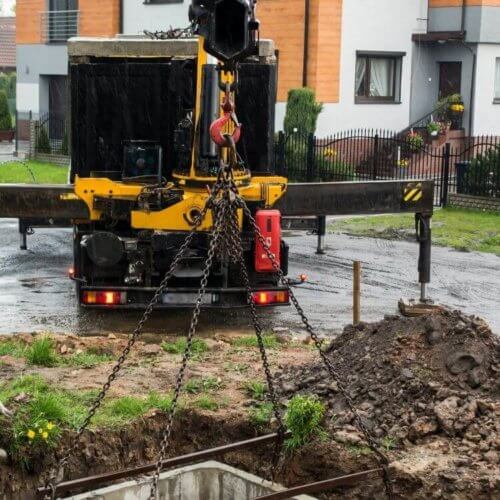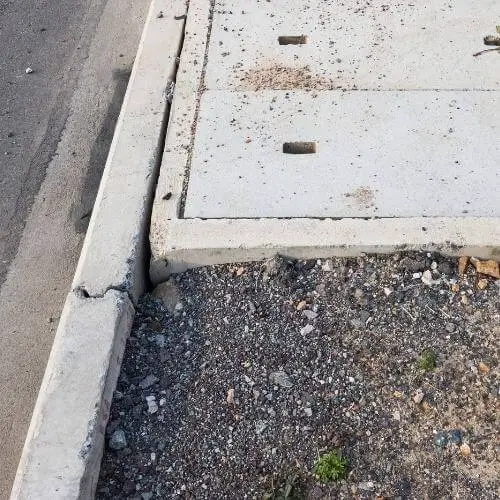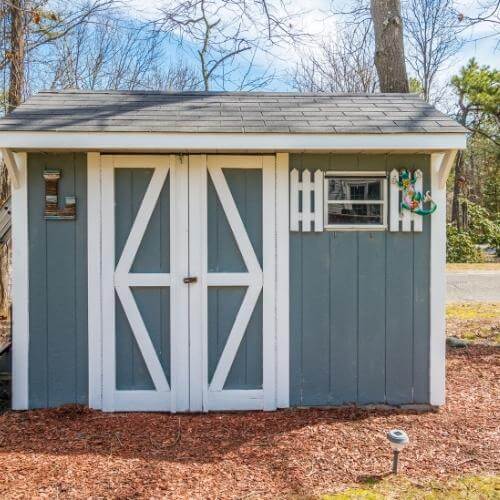Your septic tank, while out of sight, should never be out of mind for homeowners. It plays a vital ecological role in your property’s wastewater management. But what happens when you need to drive over it? Can you drive over a septic tank without damaging it?
Whether it’s for a driveway expansion, adding a new structure, or even just daily traffic, understanding the impact of vehicular activity on your septic system is always important.
In this blog post, we’ll cut through the confusion and get straight to the facts about driving over your septic tank.
Can you drive over a septic tank?

You should not drive over a septic tank. Most experts advise against you driving or parking your vehicle or any other heavy equipment on top of your septic tank. Unless the tank has special reinforcement to ensure its survival under such extreme pressure, it is best to keep off.
Otherwise, you will not only spend a lot to repair the collapsed tank but also endanger your family’s health.
It might be even worse if the problem is not discovered until it is too late. When the septic tank is located under or near the driveway, the constant pressure might result in a gradual loss of structural strength.
The tank will collapse eventually. Because septic tank systems are not designed to handle such pressure, any large or heavy machinery will lead to failure.
Related: How To Locate Water Lines In Yard
How much weight can drive over a septic tank?

There is no defined weight limit for septic tanks. It all depends on your specific tank design and the material used to construct the septic system. While some systems can bear more weight than others, it is generally recommended not to drive over a septic tank.[2]
Driving your car, tractor, or truck over the septic tank can cause undue stress and result in its collapse. Even golf carts and some heavy models of lawnmowers can cause trouble with your septic tank.
You can install vehicle-rated septic tank lids that can aid in protecting the tank located under the driveway. These are specially designed septic tank covers that can help withstand the weight of heavy equipment.
If space in your compound is an issue and you are forced to set up the tank under the driveway, consider installing one of these lids. They will help reinforce the system and possibly avert disaster.
Heavy equipment over septic tank

The heaviest machines in the home environment include tractors, bobcat machines, trucks, and lawnmowers.
Can you drive a bobcat over a septic tank? It is not a good idea to load heavy equipment over septic tank.
This includes bobcat machines as well. Even the most miniature bobcat can weigh in at over 2500 pounds, making it too heavy for the top of the septic tank.[3]
Although, in theory, you can reinforce your septic tank to withstand the weight of such machines, the investment is not worth the trouble. It is better to avoid placing any heavy load on the septic tank in the first place. Even riding mower over septic tank can prove to be problematic in case it is heavy enough.
Reasons why not to drive or park over a septic tank
- It can trigger the collapse of the tank
The primary reason why you cannot (and should not) drive over a septic tank is that it will result in the collapse of the tank. Many homeowners do not realize the danger that heavy machinery poses to their septic system. Even concrete tanks have been known to buckle and collapse under the weight of vehicles such as trucks and tractors. The problem is made worse in wet conditions.
During such seasons, the ground soaks up a lot of moisture and becomes susceptible to shifting and collapse. The tank, in this case, has to withstand both the weight of the wet soil and the heavy equipment as well. In most cases, the tank does not survive.
There is a reason why it is not recommended that septic tanks be located under driveways [4]. Septic tanks should be constructed beneath a soft land area that does not experience heavy traffic.
Similarly, the area should be marked off to discourage movement around it. This will ensure that people do not drive or park on top of the septic tank.
- Prevents access to the septic tank
On the rare occasion that the septic tank is constructed under the driveway, it is virtually impossible to access it. Access is particularly crucial when servicing and maintaining the tank.
Perhaps the tank has been filled with solids and needs to be pumped. Or maybe you need to do routine checkups and maintenance to ensure that it is operating as expected. If you park your vehicle over the lid of the septic tank, you will find it hard to reach it for maintenance.
- It is a health hazard.
A collapsed septic tank is a health hazard to the inhabitants of the house. The exposed wastewater is a fertile breeding ground for disease-causing microorganisms. Moreover, the smell of the raw sewage itself is enough to drive your family members away.
To prevent this from happening, avoid driving or parking your vehicle or heavy equipment over the septic tank. It is the best and only way to guarantee the safety and health of your family.
What if there are sewer lines and pipes under the driveway?

While it is advisable to avoid installing sewer drain lines under the driveway, sometimes this becomes inevitable. This is especially true for homeowners with reduced space on their compounds. Crowded neighborhoods mean that there is little room to maneuver in setting up sewer drain lines.
When sewer lines are located under the driveway, the sustained load of moving vehicles causes the soil to be gradually compacted. The compaction might lead to constriction and possible blockage of the sewer lines, hence slowing or completely stopping the flow of water. Similarly, the pipes themselves might end up bursting and allowing wastewater to leak onto the surface.
If you have to run a sewer pipe under the driveway to the septic tank, consider investing in protection for the tube. This can be accomplished by buying the appropriate protection material. Equally, you can opt for covering the pipe in a trench deep enough to avoid damage. For a septic tank located under the driveway, consider adopting the appropriate design. Construct the tank using material like steel or reinforced concrete. Such designs are accompanied by a vehicle-rated lid to prevent its collapse.
Can you drive over a concrete septic tank?
Even concrete septic tanks can collapse from the weight of vehicles driven over them. Unless the concrete is reinforced and its cover lid vehicle rated, it is better to be safe by avoiding driving or parking over it. However, if the tank is strengthened, you can drive over it, but ensure that you keep within the weight limit for the vehicle.
Septic system parts affected by driving over a septic tank.
The damage to the various parts of the septic system will vary depending on the position of the septic tank and the load to which it is subjected. The damage can occur at once or accumulate over time as the weight on the structure is increased gradually. Four main components of the septic system are affected if you drive over the septic tank. They are outlined below.
- Septic tank: This is the first part to be damaged by driving a vehicle over it. Tanks constructed from fiberglass, reinforced plastic, concrete, and steel are vulnerable enough to fail if heavy machines are loaded on top of them. Even concrete and steel which are known to be strong enough, can also fail when the pressure on them exceeds their capacity to bear it.
The tank develops cracks upon being loaded. Sustained loads may result in the widening of the cracks and a subsequent collapse if not addressed in time. The gaps in the tank provide openings for the sewage to leak through into the ground surrounding it. This might explain why there is a foul smell near the septic tank.
Because septic tanks are always constructed underground with soil covering it, it might be impossible to discover such cracks once they develop. Similarly, cracked tanks will allow rainwater to enter them.
The flow in the septic tank will be slowed down or even reversed. This causes the water to back up into the toilet or sink, which might create a whole load of other problems.
- Main drain pipe: Driving over the septic tank will cause undue pressure on the main drain pipe. The weight of the vehicle on the tank causes compression, which forces the wastewater to flow back into the main drain pipe. And if it is constructed from soft material such as clay pipes, its failure will occur faster. The central drain line will be damaged, causing the entire septic system to stop functioning as intended.
- Drain field: The compression from the weight of a car on the septic tank also affects the functioning of the drain field. The pipes in the field are not made to withstand a lot of pressure and may fail due to stress. Moreover, the pressure in the tank may force solid waste into the pipes. Since they are not made to handle solids, they will block quickly and cause the drain field to stop working correctly.
- Septic tank lid and riser: These are usually more vulnerable than other parts of the septic tank. Most septic tank risers and lids are constructed from reinforced plastic. As a result, they are not as capable of withstanding pressure as other parts of the tank. They are also the exposed parts of the septic tank. Thus if a vehicle drives over them, they quickly crack up and fail.
Because of the reasons stated above, you should not drive or park on or near the septic tank, drain field, or main septic piping.
Can you build on top of septic tank?

Although driving over the septic tank can be allowed in some instances, building over it is not acceptable at all. This is because of the following reasons:
- The weight of the structure could lead to a collapse.
Even a simple structure could prove to be too heavy for the septic tank, primarily if it is constructed from soft material. The combined weight of the building and the top of the tank will cause the entire structure to collapse.
The process of construction itself may also involve the use of heavy equipment, which still adds to the pressure on the septic tank [5]. You should strive to avoid it at all costs.
- Prevents proper functioning of the septic system
If you construct on top of the septic tank, you will be interfering with the functionality of the system. The central drain line, cleanout, lid, riser, and drain field all need space and air to function.
This is particularly true for aerobic septic systems. These systems rely on oxygen to break down the solids in the septic tank. Putting up a structure on top of the tank will therefore deny it the much-needed air for optimal functioning. The result will be an incomplete decomposition, a buildup of solids, and a possible blockage of the sewer lines.
- Blocks access for future repair and maintenance work
The third reason why you should not attempt to construct on top of the septic tank is that it will prevent future repair work. Structures on top of the tank will make it hard to access the lid and riser if ever there is a need to pump the tank.
You will therefore be left with two options: pull down the structure or leave your tank unattended for a long time. And you do not want to neglect your septic tank. You will be courting trouble in the form of sewage overflow and disease infestation.
Related: Can the Septic Tank Be 100 Feet from the House
Bottom Line
Taking care of your septic system, including the tank, will guarantee that it serves you well for a long time. Proper care involves avoiding placing the tank top under undue pressure. Driving a vehicle or parking it over the septic tank top can produce tremendous pressure that may result in its collapse.
Read Next: Are Septic Tanks Bad

Michael Davis is a heating & plumbing expert who currently works as independent contractor in SC. He also writes for Plumbertip.
For almost 10 years he worked on various plumbing tasks across South Carolina.


